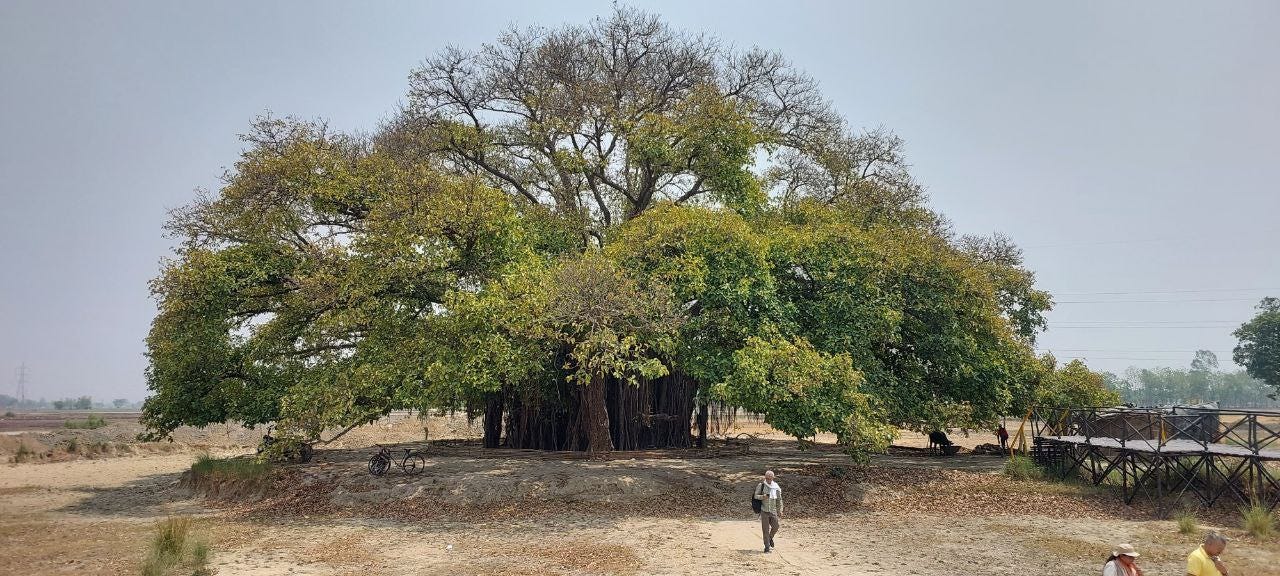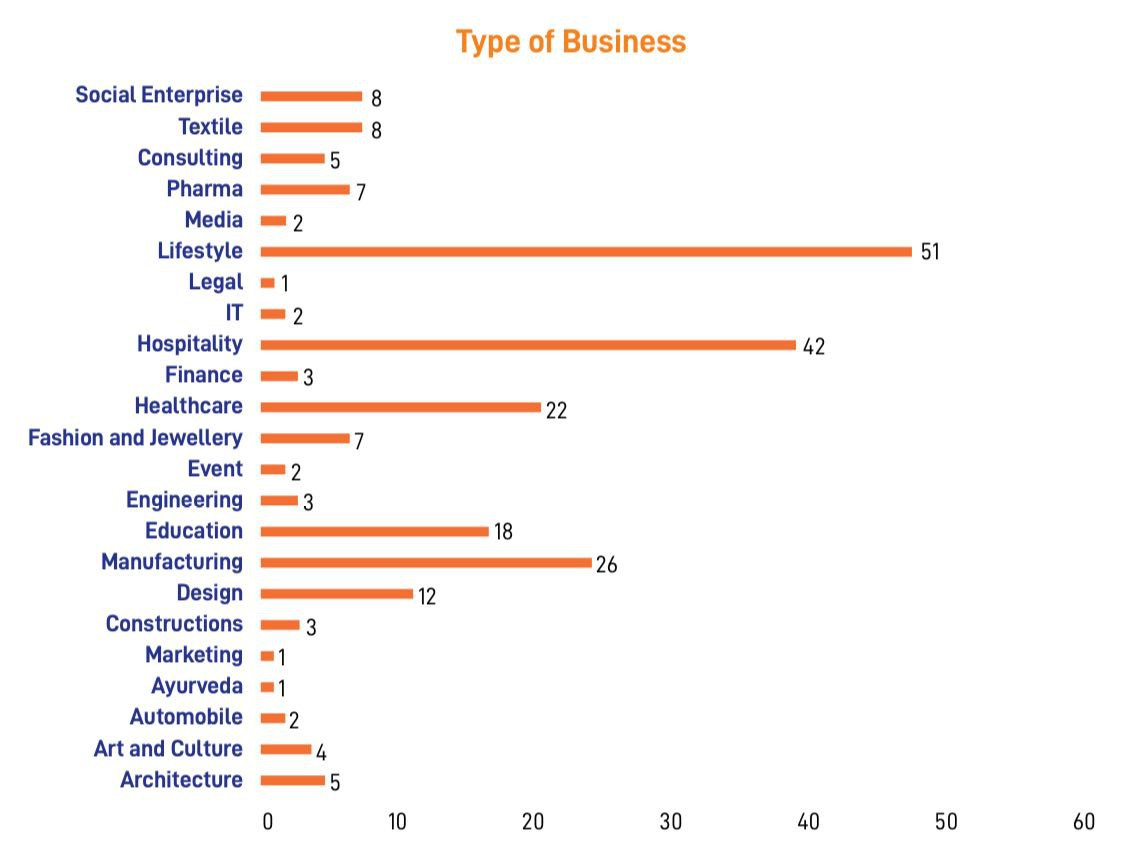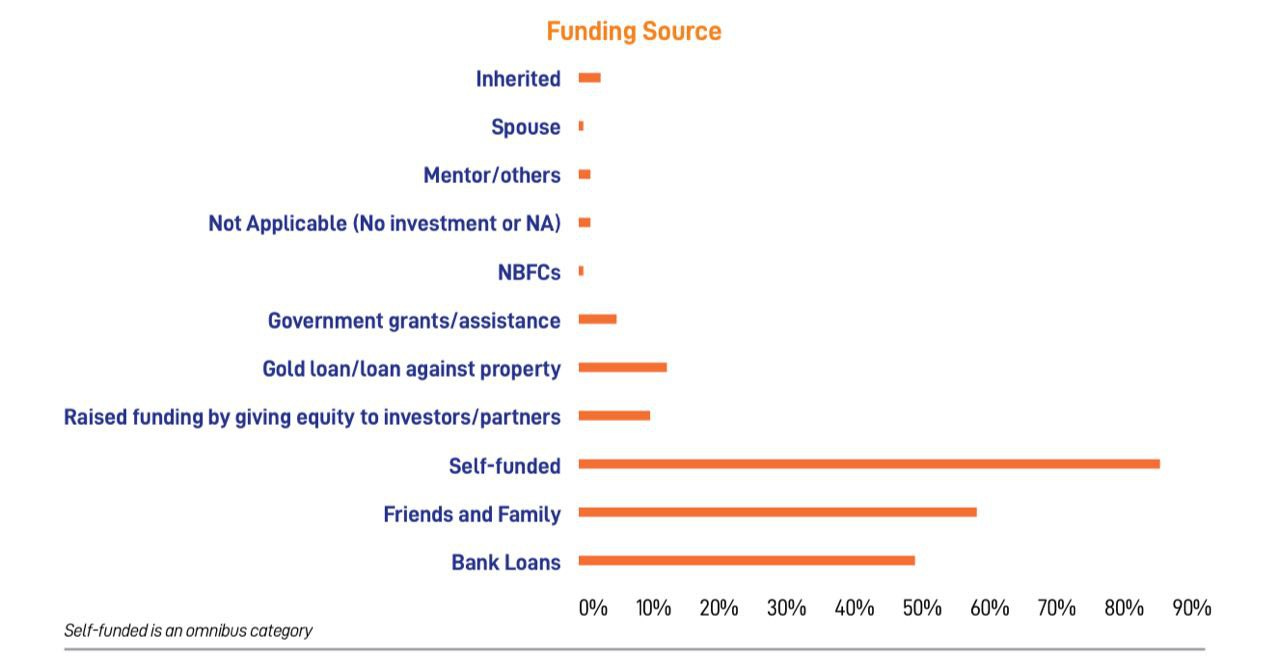The Biz Women of Middle India
A RBI Innovation Hub-SALT study flags the growing tribe of rural women entrepreneurs, but warns that constraints deny their potential. EPISODE #178
Dear Reader,
A very happy Monday to you.
Little over a week ago, the Reserve Bank of India Innovation Hub (RBIIH) released a white paper on ‘Women Entrepreneurs Transforming Middle India’ it co-authored with SALT. Coincidentally, it serves as a perfect sequel to last week’s newsletter drawing on the ground reporting from Gorakhpur about the growing tribe of women entrepreneurs in rural India.
This week I unpack the findings of this white paper, which among other things identifies the bottlenecks preventing women entrepreneurs from realising their potential in both rural India and Tier-2, Tier-3 towns—broadly defined as Middle India.
The cover picture is of this majestic Bargad or Banyan tree in Deoria, Uttar Pradesh. It is said that Buddha found enlightenment after meditating under a Bargad tree. The picture was taken by me.
Happy reading.
Missing Women Entrepreneurs
Recently, the Reserve Bank of India Innovation Hub (RBIIH) together with SALT, an organisation devoted to bridging the gap in gender finance, released a white paper. It linked India’s ability to scale its economy to $5 trillion to the speed at which it is able to nurture its women entrepreneurs in Tier-2 and Tier-3 cities—popularly referred to as middle India.
The study, largely overlooked by mainstream media, is based on conversations with 300 women entrepreneurs spread across 30 cities.
As of now this critical cohort of women entrepreneurs have demonstrated enormous potential, but are struggling for want of supporting ecosystems, especially in access to credit and fighting gender stereotypes. Their underrepresentation in national entrepreneurship can only be corrected by fixing these gaps, the white paper concluded.
The timing of the study is excellent. It comes in the backdrop of a public policy pivot over the last decade, which led to a host of initiatives undertaken by the union and state governments to empower women. A strategy inspired by teaching people how to fish, rather than being given fish. Especially in solving for staggering scale, the access to basics like electricity, banking, cooking gas, housing, drinking water, health insurance and so on.
Not surprisingly, this empowerment coincides with growing autonomy among women voters—who, for the first time in the 2019 general election, topped the turnout of their male counterparts—in exercising their electoral choice.
The New Economic Powerhouse
Last week I had combined my ground report from Gorakhpur and Deoria to argue how the coming out of women voters will be the trend to watch for on 4 June, when the votes are tallied to decide the winner of this general election.
In case you missed it or wish to re-read it please click the link below:
The X Factor in #Polls2024
Dear Reader, A very happy Monday to you. Last week I stumbled upon a news clip featuring Pradeep Gupta, CMD of Axis My India and the psephologist with the golden touch in calling elections. In an interview to India Today TV, he argued that in this general election the women voter will influence the outcome.
The RBIIH-SALT white paper rightly identifies Middle India as the rising economic powerhouse. According to it, the growth in Tier-1 India has maxed out and focus has shifted to Tier-2 and Tier-3 cities.
Identifying the new growth opportunity the paper said:
“Tier 2 and tier 3 cities, interchangeably referred to as Middle India, are emerging as pivotal economic and urban centres. Women entrepreneurs can play a crucial role in this transformation.”
And then added (bold text is my doing):
“This study, which involved speaking to 300 women entrepreneurs across these cities, dives deep into the socio-economic dynamics influencing women’s entrepreneurship. India’s falling female workforce participation has been a baffling challenge, especially given this country’s achievements in high STEM and postgraduate education for girls.
Over the last two decades, there has been a better understanding of conscious and unconscious bias in workplaces and legislative measures on childcare and safe workplaces have been implemented.
However, similar understanding of the female entrepreneurial ecosystem is extremely limited in general, and almost absent in case of Tier 2 and 3 India.”
Tier-2 and Tier-3 cities, which account for a little less than half of the country’s population and a little over a third of the gross domestic product, are identified as the emerging urban centres. The list includes, cities like Amritsar, Bhopal, Bhubaneswar, Chandigarh, Faridabad, Ghaziabad, Jamshedpur, Jaipur, Kochi, Lucknow, Nagpur and Patna.
The findings of the white paper about the growth potential of Middle India are borne out by a study released by Primus Partners, a business and management consulting firm, in January this year.
The demographics captured in the study are:
85% and 75% literacy rates in Tier-2, Tier-3 cities respectively;
10 unicorns are located in Tier-2, Tier-3 cities.
It then went on to add (bold text is my doing):
“The Tier 2 and Tier 3 cities of India are currently experiencing an extraordinary economic surge, catalysed by a burgeoning demographic of youth, transformative economic dynamics, and a richly diverse social and cultural tapestry.
The favourable conditions make these cities excellent places for nurturing innovation and entrepreneurial ventures. Aspiring individuals who recognise and harness their potential within these cities stand poised to embrace a promising and prosperous future.”
Basically, both RBIIH-SALT and Primus Partners are arguing that the centre of gravity of economic growth is shifting to Middle India.
The table below, sourced from the Primus Partners study, comparing the growth of startups over the years across Tier-1 and Middle India captures this trend brilliantly. It is evident that Tier-1 has been overtaken and that too on staggering terms. Even better, growth of startups in Tier-3 led Tier-2, excepting for 2023 when they were tied—a year when Tier-1 registered only a 10% growth in startups.
The Findings
Therefore, the RBIIH-SALT white paper is on the money when they claim that it makes excellent sense to seize the growth momentum in Middle India and grow the opportunity to its potential by tapping women entrepreneurs.
Basically democratise entrepreneurship opportunities such that even women are part of the growth story. Not just to enable gender parity.
As the paper puts it, this makes eminent economic sense too, as India can grow faster and thereby achieve the economic milestones it has set itself even earlier.
Remember, missing women in the workforce in India is a public policy challenge; entrepreneurship provides a perfect launch pad to correct for this imbalance.
At present, India lags most of the G20 countries in terms of proportion of women-owned businesses. While Russia tops it at 35%, India has only 11% women-owned businesses.
Broad findings of the study are as follows:
A diverse and educated group of women entrepreneurs with 14% holding graduate degrees and over on in two women having pursued higher education;
Their age distribution varies between 30-60 years;
Marriage and migration are significant factors impacting their entrepreneurial paths;
Little over a third of the respondents had to pause their entrepreneurial efforts to attend to caregiving responsibilities;
They operate across a variety of sectors, challenging stereotyping of women entrepreneurs (check graphic above sourced from the white paper);
Nine out of ten women entrepreneurs were the primary decision makers in their business, signalling their autonomy and leadership.
The biggest constraint facing women entrepreneurs is the access to credit. The main reason for this is that most household assets are in the names of men and hence women find it a challenge to put up collateral.
The study notes (the bold text is my doing):
“Financially, 62% were self-funded, while 14.9% received support from friends and family. The credit access disparity was evident and few had accessed borrowing to scale their business.
On average, across India, women receive credit for only up to 27% of deposits made by them, whereas men receive up to 52%, demonstrating a gender gap of 25% in access to credit on deposits.”
As a result, the primary choice is to bootstrap the enterprise. Check out the graphic below:
Death of Distance
One of the most remarkable features of India, since the turn of the Millennium, is the public policy focus on rural road connectivity.
It was initiated by the first Bharatiya Janata Party (BJP)-led National Democratic Alliance (NDA) under the leadership of Atal Bihari Vajpayee. The flagship scheme, Pradhan Mantri Gram Sadak Yojana (PMGSY), gradually acquired momentum under the Congress-led United Progressive Alliance led by Prime Minister Manmohan Singh. There is no doubt that the pace of rural road building picked up during the tenure of NDA 2.0 led by Prime Minister Narendra Modi, which assumed power in 2014.
More importantly, in little over two decades India has built/re-developed over 600,000 km of rural roads. Together with the massive ramping up of infrastructure—highways, airports, railways, ports—and Internet connectivity, especially in the post-Jio world, has made it possible to bridge the challenge of geography. This is exactly why the centre of gravity of India’s growth momentum is shifting to Middle India.
The study notes as much:
“The transformative power of technology and the internet has solved many issues that entrepreneurs in these geographies faced in the past. It is not just the new airports, high-speed trains and faster highways that have reduced distances and added time and choices to these businesses.
High-speed internet and video calling applications have also made it possible to manage businesses remotely, effectively diminishing geographical barriers and enabling seamless coordination with teams across various locations.”
In the aftermath of covid-19, remote working has emerged as a new norm, helping level the playing field with respect to a class of rural women entrepreneurs.
In the final analysis it is clear that India is staring at a huge opportunity in realising the potential of women entrepreneurs in Middle India. I leave the final word to the RBIIH-SALT white paper.
“Providing tangible fiscal benefits for business growth or to offset childcare expenses, dealing with unconscious bias, using technology, state and city-level infrastructure support, and fostering public-private partnerships with a specific focus on women from this vast talent pool, will turn the ambition of women-led growth into action.
This approach doesn’t just aim for growth; it aims for a revolution in how we value women’s economic contributions.
The potential is vast, the path is clear, and the time is now.”
Recommended Viewing/Reading
Sharing the latest post of Capital Calculus on StratNews Global.
Recent statements by senior members of the Congress party, including former President Rahul Gandhi, has put the spotlight on the problem of inequality in India. The claim which has come in the middle of a very contentious general election campaign is triggering acrimonious exchanges.
The resulting noise has turned this exchange into a political slug fest instead of a healthy debate. To be sure, neither is this the first time that the problem of inequality is being flagged, nor is this challenge unique to India.
The question is whether the claim of the Congress party is true? To do this fact check StratNews Global spoke to Rajesh Shukla, CEO, PRICE or People Research on the Indian Consumer Economy.
Sharing the link below. Do watch and share your thoughts.
Till we meet again next week, stay safe.
Thank You!
Finally, a big shoutout to Debu, Premasundaran and Shiv for your informed responses, kind appreciation and amplification of last week’s column. Once again, grateful for the conversation initiated by all you readers. Gratitude also to all those who responded on Twitter and Linkedin.
Unfortunately, Twitter has disabled amplification of Substack links—perils of social media monopolies operating in a walled garden framework. I would be grateful therefore if you could spread the word. Nothing to beat the word of mouth.
Reader participation and amplification is key to growing this newsletter community. And, many thanks to readers who hit the like button😊.








A very important and interesting article Anil. Finely analyzed and precisely composed. The participation of women in the Indian economy is critical for achievement of the 5tr$ mentioned during election campaigns, propelling India to the position of the 3rd largest economy in the world. The scope for growth shifting to the tier 2 and 3 cities is excellent news and women entrepreneurs could do well in a number of industries; especially in manufacturing of garments, herbal products, cosmetics, handloom, kitchen ingredients; units that may employ large number of women. Although the sky is the limit and some may even venture into computer chips; the participation of women as entrepreneurs will inspire and inject confidence into this dormant human resource. Keep enlightening us Anil and we will look forward to your Monday articles.